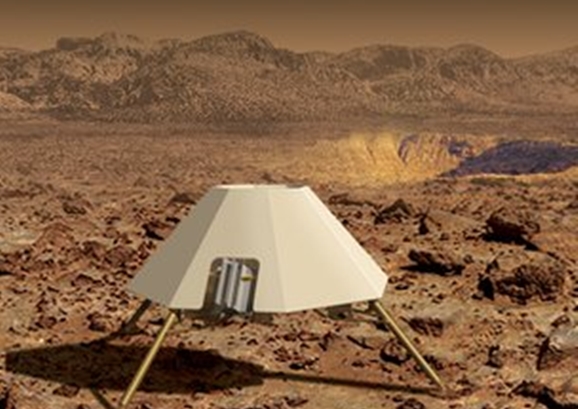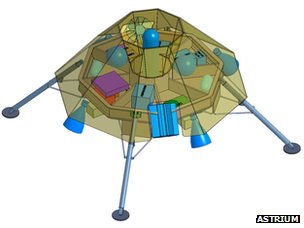Hopper Craft May Leap Instead Of Drive Across Mars
This article is more than 2 years old
 Let’s get one thing straight: the Curiosity Rover is bad-ass. It has uncovered all kinds of amazing evidence supporting the notion of water, and possibly even life, on Mars. Still, some scientists wonder whether roving is the best way to traverse the red planet. A proposal from Leiscester University and European space company Astrium, now funded by the ESA, involves a new design — a hopper.
Let’s get one thing straight: the Curiosity Rover is bad-ass. It has uncovered all kinds of amazing evidence supporting the notion of water, and possibly even life, on Mars. Still, some scientists wonder whether roving is the best way to traverse the red planet. A proposal from Leiscester University and European space company Astrium, now funded by the ESA, involves a new design — a hopper.
True to its name, the vehicle would leap across the surface of Mars, thus eliminating the need for wheels. The advantage is that much of Mars’ surface is covered with boulders, hills, craters, and sand — in fact, the Curiosity Rover will have to deal with some pretty major sand traps on its way to Mount Sharpe. The leaping system makes it much easier for a vehicle to navigate this type of terrain.

The hopper would weigh over 2,000 pounds, have a leg span of about 13 feet, and have a body roughly eight feet across. Its success relies on a new propulsion system that researchers have been working on for the past three years. The vehicle would extract carbon dioxide from the air, compress it, then liquefy it. It would then pump the liquefied CO2 into a chamber where it would then subject it to extreme heat from a radioisotope. Then, as you might imagine, the CO2 would explode. This explosion would be directed through a nozzle that would propel the craft into the air, and would theoretically cause enough force to propel a one-ton spacecraft about 3,000 feet.
If this works, at thousands of feet per leap, the hopper would be able to cross distances far faster than a rover. It would also be able to jump into and out of craters. The biggest hitch thus far with the C02 propulsion system is that it takes a long time — weeks — for the process to produce enough propellant material to actually launch the craft.
Another challenge in the hopper system is that it needs legs that can soften and absorb the impact of the vehicle. The current approach involves a cushiony material along the lines of honeycomb to help soften the impact. The problem with that design is that the Hopper would want to jump again, so it needs some kind of landing system that allows for a quick landing-to-launch turnaround.

The team is currently working on a magnetic system that would use opposing magnetic fields to dampen the landing. An added bonus is that the magnetic system doesn’t involve hydraulic fluids, which could be problematic in colder Martian temperatures.
Scientists have contemplated a bunch of ideas for different vehicle designs, including a wind-blown tumbleweed concept, balloons, and various types of planes. While it’s unclear exactly what, if anything, will happen with the Mars hopper, including being scooped by similar hoppers designed by folks at places like MIT and Lehigh University (see video below), Astrium missions systems engineer Mike William is confident that, unlike some of the other new ideas for surface-bound vehicles, this one is “feasible.” Not quite a ringing endorsement, but this project may have legs yet.












